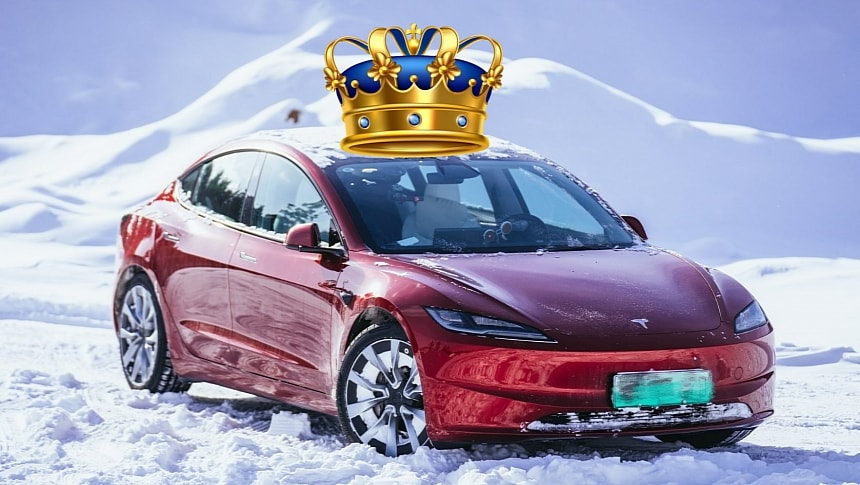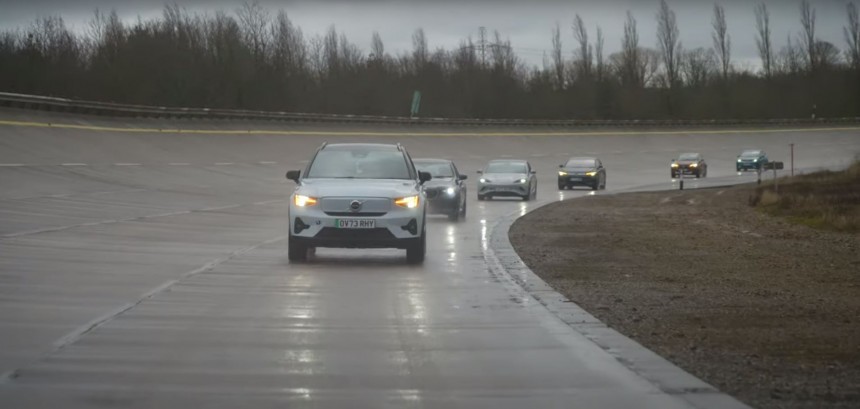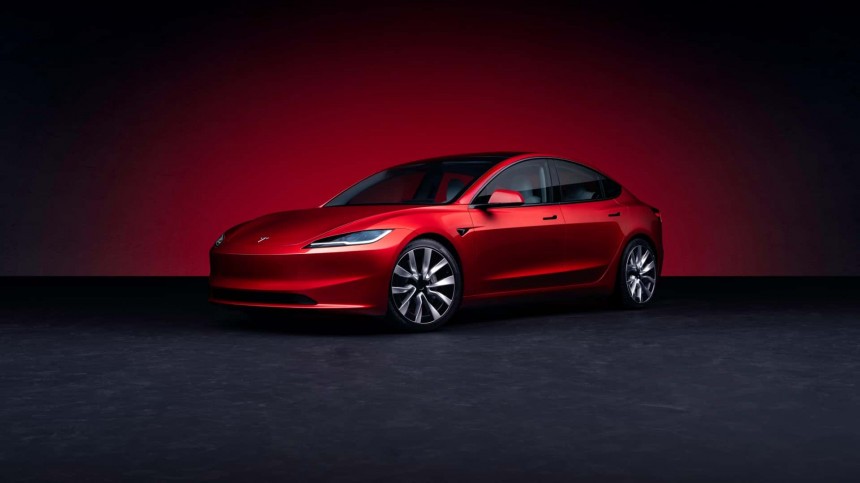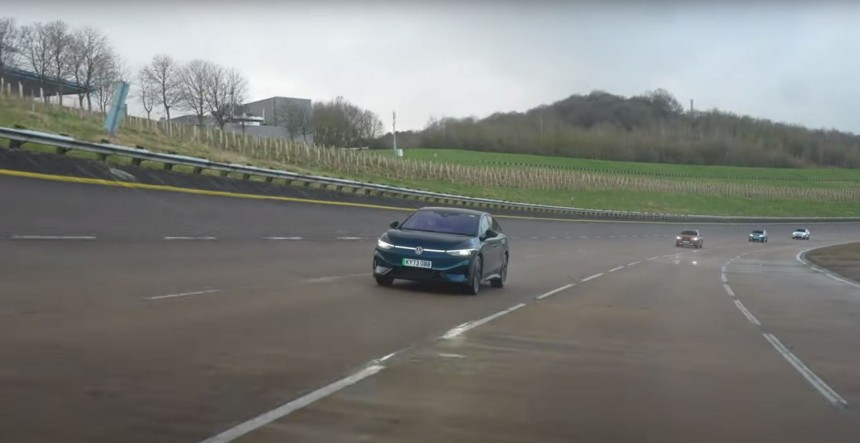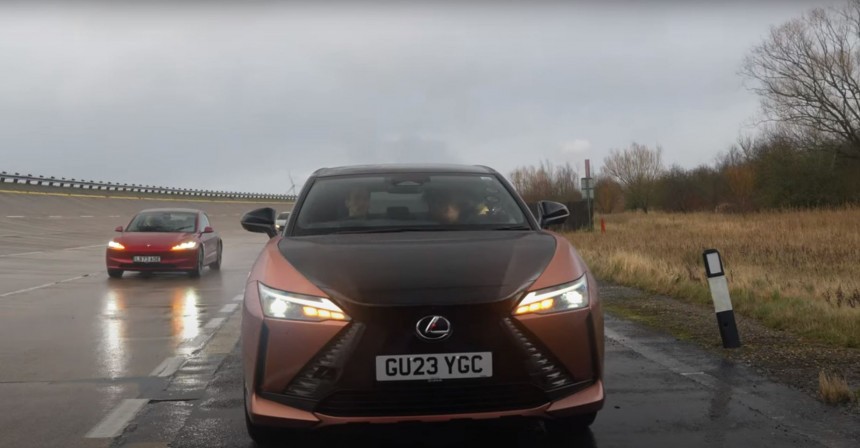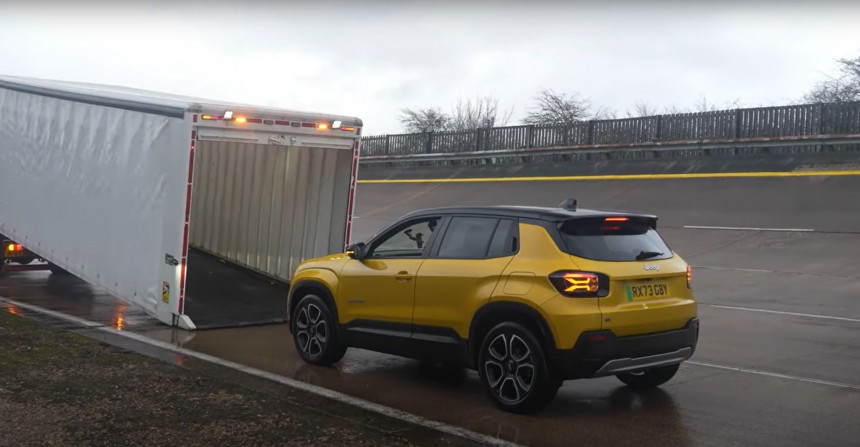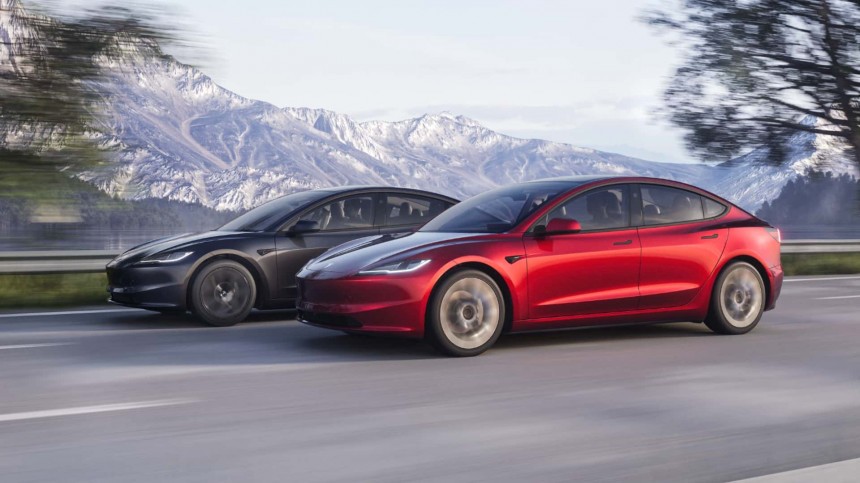For quite some time now, Tesla has been the obvious choice for anyone considering an EV. The brand may be led by a very outspoken and unusually opinionated person, and it may not value build quality very much. Still, it has created and refined what arguably is the best battery-electric powertrain out there. Still, some of its new rivals put the brand through its paces in a simulated real-world range test.
Look, let's be honest with ourselves for a brief moment: Tesla is the best when it comes to EVs. Except for the experimental Cybertruck, the S, 3, X, and Y are great "zero-emission" rides. If you're ready to abandon the internal combustion engine, then there's no better brand out there that can give you an EV capable of doing a bit more than just being a plain and boring commuting appliance.
Shall I remind you that you can play modern video games or stream high-quality movies in almost any of the post-2019 Teslas? And that's just one of the extras the brand included in its cars because it understood very early that software (and good hardware) would be incredibly important moving forward.
Okay, enough praise for the world's most valuable automaker, led by the world's second-richest person, who can sometimes be pretty petty or childish. But you can't run multiple successful companies without taking the edge off once in a while, I guess.
Before we look at the testing procedure and its outcome, let's settle a couple of things.
Firstly, most electric vehicles you can buy today are great. They help us start solving a major problem – global warming. Road transport plays a big part in the pollution of our planet. In the US, 29% of all greenhouse gas emissions (GHGs) come from the transportation sector. Light-duty vehicles (i.e., sedans, wagons, CUVs, SUVs, etc.) and medium- and heavy-duty trucks are responsible for 81% of the GHGs that end up in the atmosphere. No matter how you look at it, that's… A lot. We're not making these figures up. They are provided by the Environmental Protection Agency (EPA).
Secondly and surprisingly, aviation represents just 8% of the pie. Based on the recent news about stars using private planes, you would think flying is going to kill us all faster than something like an Ebola outbreak could.
So, despite all the contemporary talking points about the industry and customer preferences, the EV was necessary. It will help us lower GHGs. Nobody knows exactly how fast GHG emissions will drop once EVs are mainstream in most countries around the world. Still, the consensus is that we need to completely electrify cars, pickup trucks, semi-trucks, and construction and mining vehicles. I don't disagree.
Thirdly, EVs aren't the cleanest cars in the world. They might not have an exhaust system, but they do have their own carbon footprint. Sadly, it is quite a big one. Mining for all sorts of metallic elements, long supply chains, and assembly without the use of clean energy are just some of the culprits that make an EV dirtier than the equivalent internal combustion engine-powered car when both are ready to leave the factory.
Fourthly, EVs are also a bit more expensive because legacy automakers spent their money on refining the internal combustion engine. When Tesla became unexpectedly successful, and governments started announcing bans on the sales of new fossil fuel-hungry cars, industry titans had to make the switch. That cost a lot of money. The process is still expensive. Billions of dollars are being poured into EV development.
Normally, a vehicle would be made of thousands of parts. Since EVs need only about 200 parts and have a big battery built into the floor (which plays an important structural role), carmakers simplified their platforms. Remember the $41,000 Rivian R1T fender bender? Well, that's because the brand decided to use a couple of humongous panels instead of many smaller ones.
Tesla is another example in this regard. Its gigacasting process made waves last year as being revolutionary. However, a couple of unlucky buyers discovered that their EVs came with cracks from the factory. That's worrying because the castings are glued to the structure and irreplaceable. Customers should've had their faulty Teslas replaced for free, but the marque basically told them those cracks were within spec.
Officially, the cracks were named "discontinuities." In English, that means "slight production imperfections." I wouldn't say that a visible crack in the underbody is an imperfection, but what do I know, right? I'm not a Tesla technician.
Scrapping an entire car because of a production error does seem a bit extreme for a "green" vehicle, but maybe that's part of the sacrifices we need to make in order for the internal combustion engine to have a peaceful death.
Sixthly, there's the issue of high-voltage batteries failing and not being replaced under warranty. Those are expensive! It can happen. Hyundai owners dealt with it and had to press the automaker for a fix after they claimed that a slight design error led to the high-voltage energy storage unit failing too easily in case of an unexpected underbody impact.
Besides per capita battery replenishing costs, charging an ever-increasing number of EVs brings us new challenges. Is all this electricity green? If it is, great! It's all good. We're making progress. If it's not from solar farms, hydropower plants, or groups of wind turbines, then we're not doing everything in our power to tackle global warming. We're just enjoying instant torque and cars that are a bit more silent (and expensive).
Considering all the above, the world of EVs is anything but simple. Some can even argue that these battery-powered rides put more strain on the environment (remember the Thacker Pass debacle?) than gas-powered cars.
However, two things can't be stolen from EVs: they are more silent (noise pollution is a real thing) and a whole lot better for any local environment. Imagine a city like Liverpool or Chicago where everything with two or more wheels is either human- or battery-powered. The air would be much cleaner, and you would never have to wear headphones because the city's too loud. China's Shenzen is already one of the quieter megacities.
After a driver completed a full session, they would stop and get behind the wheel of another participating EV. The organizers wanted to eliminate any possible errors.
Outside conditions weren't great, but that's expected from British weather.
Here's how the EVs fared on this range test:
That 14 kWh of extra battery helped the German sedan finish in first place with a respectable result, considering the test procedure and the average temperature of 52 F (11 C). However, Tesla won where it matters – at energy consumption!
The Model 3 Long Range scored an efficiency of 3.9 mi (6.3 km) per kWh. It was followed by the:
Tesla is the undisputed king of efficient all-electric powertrains. VW is making a strong push in this direction, and Mercedes-Benz might have what it takes to close in on the industry leader, but legacy automakers are still behind.
We don't even have to look at what BMW or Mercedes-Benz ask for their EVs. We already know they'll be expensive and pretty boring without some extras.
So, what can a driver looking to experience the EV life and maybe shrink his personal carbon footprint (yes, it is a thing people believe in) do in this situation? Well, you must first assess if an EV is good for you. Answer the questions below before starting to look around.
Can you charge at home overnight or at work for a free/discounted rate? Public fast charging can be incredibly pricey!
Are you ready to see the expected range halve during harsh winters? Weather can severely impact your EV's maximum range on a single charge.
Do you travel long distances regularly without having to stick to a strict schedule? Even though fast-charging options are ever-expanding, it still takes about 25-35 minutes to replenish a high-voltage energy storage unit before hopping onto the next station.
Do you tow often? Range may halve when hooking a trailer or an RV to your EV. You may have to stop at more high-power public dispensers, which means you'll pay more to cover your route.
Can you stomach a higher insurance premium? EVs are generally costlier to fix (by about 26%) and are often totaled after only a small accident.
But above all else, EVs currently depreciate faster than conventional cars. They lose more value than even luxury rides. However, that's the good news. There are tons of deals out there. You could buy an Audi e-tron or e-tron GT for much less than early adopters paid for them. You can also take advantage of the used EV tax credit, which is Uncle Sam's way of helping eligible car buyers add a $4,000 discount to used EVs costing $25,000 or less.
Finally, Tesla remains the obvious choice for many car buyers who want a good EV with native access to the best North American high-power charging network. But if you can truly accommodate an EV in your life, a used one that has depreciated considerably and may have some warranty left is a good idea, especially in today's economic environment where money's very expensive. Many of us don't commute hundreds of miles on a daily basis, which means a non-Tesla EV can be a great addition to the driveway.
Shall I remind you that you can play modern video games or stream high-quality movies in almost any of the post-2019 Teslas? And that's just one of the extras the brand included in its cars because it understood very early that software (and good hardware) would be incredibly important moving forward.
Okay, enough praise for the world's most valuable automaker, led by the world's second-richest person, who can sometimes be pretty petty or childish. But you can't run multiple successful companies without taking the edge off once in a while, I guess.
Before we look at the testing procedure and its outcome, let's settle a couple of things.
Unwind and rewind
If you're an experienced EV owner, then feel free to scroll through this. If you're not, you might want to read this short introduction to the "zero-emission" motoring world.Firstly, most electric vehicles you can buy today are great. They help us start solving a major problem – global warming. Road transport plays a big part in the pollution of our planet. In the US, 29% of all greenhouse gas emissions (GHGs) come from the transportation sector. Light-duty vehicles (i.e., sedans, wagons, CUVs, SUVs, etc.) and medium- and heavy-duty trucks are responsible for 81% of the GHGs that end up in the atmosphere. No matter how you look at it, that's… A lot. We're not making these figures up. They are provided by the Environmental Protection Agency (EPA).
Secondly and surprisingly, aviation represents just 8% of the pie. Based on the recent news about stars using private planes, you would think flying is going to kill us all faster than something like an Ebola outbreak could.
So, despite all the contemporary talking points about the industry and customer preferences, the EV was necessary. It will help us lower GHGs. Nobody knows exactly how fast GHG emissions will drop once EVs are mainstream in most countries around the world. Still, the consensus is that we need to completely electrify cars, pickup trucks, semi-trucks, and construction and mining vehicles. I don't disagree.
Thirdly, EVs aren't the cleanest cars in the world. They might not have an exhaust system, but they do have their own carbon footprint. Sadly, it is quite a big one. Mining for all sorts of metallic elements, long supply chains, and assembly without the use of clean energy are just some of the culprits that make an EV dirtier than the equivalent internal combustion engine-powered car when both are ready to leave the factory.
Costs and headaches
Fifthly, if you buy an EV, you might see higher insurance premiums. It is unfortunate, but it's the outcome of companies like Tesla investing in production methods that transform car making as we know it into a Lego-like process. Newcomers figured out that assembling a car through processes requiring less human work is cheaper and faster.Normally, a vehicle would be made of thousands of parts. Since EVs need only about 200 parts and have a big battery built into the floor (which plays an important structural role), carmakers simplified their platforms. Remember the $41,000 Rivian R1T fender bender? Well, that's because the brand decided to use a couple of humongous panels instead of many smaller ones.
Tesla is another example in this regard. Its gigacasting process made waves last year as being revolutionary. However, a couple of unlucky buyers discovered that their EVs came with cracks from the factory. That's worrying because the castings are glued to the structure and irreplaceable. Customers should've had their faulty Teslas replaced for free, but the marque basically told them those cracks were within spec.
Scrapping an entire car because of a production error does seem a bit extreme for a "green" vehicle, but maybe that's part of the sacrifices we need to make in order for the internal combustion engine to have a peaceful death.
Sixthly, there's the issue of high-voltage batteries failing and not being replaced under warranty. Those are expensive! It can happen. Hyundai owners dealt with it and had to press the automaker for a fix after they claimed that a slight design error led to the high-voltage energy storage unit failing too easily in case of an unexpected underbody impact.
The little (big) things
Then, we're getting into other issues like charging. In many parts of the US, fast charging an EV has become more expensive than filling up with gas. Many Tesla and Rivian owners have already reported that they haven't seen any savings by switching to an all-electric lifestyle. Early adopters had the perk of free fast charging, but that's gone now. You either charge at home or pray that the dispenser you're hooking your car to isn't going to drain your wallet.Considering all the above, the world of EVs is anything but simple. Some can even argue that these battery-powered rides put more strain on the environment (remember the Thacker Pass debacle?) than gas-powered cars.
However, two things can't be stolen from EVs: they are more silent (noise pollution is a real thing) and a whole lot better for any local environment. Imagine a city like Liverpool or Chicago where everything with two or more wheels is either human- or battery-powered. The air would be much cleaner, and you would never have to wear headphones because the city's too loud. China's Shenzen is already one of the quieter megacities.
Wait a minute! Why is Tesla at the top of the EV food chain?
Now, onto the range test. The What Car? team picked some of the most well-known EVs and drove them until they reached a zero percent state of charge (SoC). They decided to run it on a closed track. The EVs were fully charged the night before the test and had to follow a strict track procedure comprising:- 2.6 miles (4.2 kilometers) of 30 mph (48 kph) driving;
- 4.0 miles (6.4 kilometers) of 50 mph (80 kph) driving;
- 8.0 miles (12.8 kilometers) of 70 mph (113 kph) driving.
After a driver completed a full session, they would stop and get behind the wheel of another participating EV. The organizers wanted to eliminate any possible errors.
Here's how the EVs fared on this range test:
- Lexus RZ 450e (64 kWh usable battery) – 157 miles (253 kilometers); [251 miles of official range]
- Jeep Avenger (50.8 kWh usable battery) – 163 miles (262 kilometers); [244 miles of official range]
- BYD Dolphin (60.4 kWh usable battery) – 188 miles (303 kilometers); [265 miles of official range]
- MG 4 Extended Range (74.4 kWh usable battery) – 227 miles (365 kilometers); [323 miles of official range]
- Volvo XC40 ((aka the EX40) 79 kWh usable battery) – 232 miles (373 kilometers); [331 miles of official range]
- BMW i5 eDrive40 (81.2 kWh usable battery) – 253 miles (407 kilometers); [338 miles of official range]
- VW ID.7 Pro ((no heat pump) 77 kWh usable battery) – 254 miles (409 kilometers); [383 miles of official range]
- BYD Seal (82.5 kWh usable battery) – 255 miles (410 kilometers); [354 miles of official range]
- VW ID.7 Pro ((with a heat pump) 77 kWh usable battery) – 268 miles (431 kilometers); [381 miles of official range]
- Tesla Model 3 Long Range (75 kWh usable battery) - 293 miles (472 kilometers); [390 miles of official range]
- Mercedes-Benz EQE 300 (89 kWh usable battery) – 300 miles (483 kilometers). [380 miles of official range]
That 14 kWh of extra battery helped the German sedan finish in first place with a respectable result, considering the test procedure and the average temperature of 52 F (11 C). However, Tesla won where it matters – at energy consumption!
- VW ID.7 with a heat pump – 3.5 mi (5.6 km) per kWh;
- Mercedes-Benz EQE – 3.4 mi (5.4 km) per kWh;
- VW ID.7 with no heat pump - 3.3 mi (5.3 km) per kWh;
- Jeep Avenger – 3.2 mi (5.1 km) per kWh;
- BMW i5/BYD Dolphin/BYD Seal/ MG 4 – 3.1 mi (5 km) per kWh;
- Volvo XC40 – 2.9 mi (4.6 km) per kWh;
- Lexus RZ 450e – 2.5 mi (4 km) per kWh.
Tesla is the undisputed king of efficient all-electric powertrains. VW is making a strong push in this direction, and Mercedes-Benz might have what it takes to close in on the industry leader, but legacy automakers are still behind.
One problem and one (or more) suggestion(s)
It's all good and dandy that we have so many EVs on the market nowadays. There's but one problem: price. The Model 3 Long Range is almost $48,000 before tax and possible incentives. Leasing one is not a very good idea because there's no buyout option. Financing is a stretch, too, sadly. These current rates of over eight percent are not enticing at all.We don't even have to look at what BMW or Mercedes-Benz ask for their EVs. We already know they'll be expensive and pretty boring without some extras.
So, what can a driver looking to experience the EV life and maybe shrink his personal carbon footprint (yes, it is a thing people believe in) do in this situation? Well, you must first assess if an EV is good for you. Answer the questions below before starting to look around.
Are you ready to see the expected range halve during harsh winters? Weather can severely impact your EV's maximum range on a single charge.
Do you travel long distances regularly without having to stick to a strict schedule? Even though fast-charging options are ever-expanding, it still takes about 25-35 minutes to replenish a high-voltage energy storage unit before hopping onto the next station.
Do you tow often? Range may halve when hooking a trailer or an RV to your EV. You may have to stop at more high-power public dispensers, which means you'll pay more to cover your route.
Can you stomach a higher insurance premium? EVs are generally costlier to fix (by about 26%) and are often totaled after only a small accident.
But above all else, EVs currently depreciate faster than conventional cars. They lose more value than even luxury rides. However, that's the good news. There are tons of deals out there. You could buy an Audi e-tron or e-tron GT for much less than early adopters paid for them. You can also take advantage of the used EV tax credit, which is Uncle Sam's way of helping eligible car buyers add a $4,000 discount to used EVs costing $25,000 or less.
Finally, Tesla remains the obvious choice for many car buyers who want a good EV with native access to the best North American high-power charging network. But if you can truly accommodate an EV in your life, a used one that has depreciated considerably and may have some warranty left is a good idea, especially in today's economic environment where money's very expensive. Many of us don't commute hundreds of miles on a daily basis, which means a non-Tesla EV can be a great addition to the driveway.
